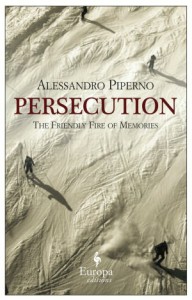If the title of Alessandro Piperno’s second novel, Persecution, suggests a political allegory, its subtitle, The Friendly Fire of Memories, alludes to its Proustian pretentions. Yet both implications remain unfulfilled. This is the tantalizing nature of Persecution, a story that examines the downfall of the renowned doctor Leo Pontecorvo after he is accused of having sexual encounters with the 12-year-old girlfriend of his younger son, a story with which we are uncomfortably familiar in this day and age.
The novel’s prose is in an unrelenting — one might indeed say militant — style maintaining an equal pitch of fervor and bitter irony at all moments. It demands that the reader follow Piperno on complex syntactical jaunts through the relived pasts of his characters. Piperno’s retrospective technique might be described very well by the title of the book. For Piperno, “persecution” at times evokes a comparison between the Jews’ plight in World War II and the apparently unbearable social pressures faced by an upper-class Roman Jew of the 1980s; an offensive comparison which belies the arrogance with which the author approaches the delicate task of novel writing. The novel is ultimately more a display of masculine intellectual dominance than a portrait of the complexities of social class and modern religious attitudes.
Though the basic premise of Persecution may not seem so absurd to the contemporary reader, a sense of unreality is introduced by the form the protagonist’s isolation takes: Leo exiles himself to his basement and lives, unacknowledged, below his wife and two children in shame and ever-mounting paranoia. A similar scenario is chronicled in such stories as Kafka’s “The Metamorphosis” (a reference Piperno can’t help but making) and Tolstoy’s “The Death of Ivan Ilyich.” In both cases the protagonist, leaving a life of normalcy and work, enters the realm of the strange and metaphysical. Such is true of Leo Pontecorvo as well. But Piperno has faltered at two childish stumbling blocks.
The first is the author’s fondness for introducing events only so that he can expose a preconceived package of memories, not all of which seem to center on the dying man’s portrait. Like inspecting the colon when symptoms all point to emphysema, Piperno seems to lose track of his purpose in order to demonstrate his capacity to examine. For example, near the end of the novel it is revealed that the illustrations scattered throughout the book are not mere adornments, but replications of images — some of events that only Leo could have known about — which were surreptitiously slipped under the door to his room of exile. Leo concludes that this confirms his deepening belief (not yet really alluded to in the story) in a “presence,” some more divine purpose, which is meant to reveal to him what all of this means. But the conclusion, in a bluntly existentialist fashion, is that there is no meaning at all. But from where does this deduction stem? The novelty of the conceit is only surpassed by the unnecessary “literariness” of its conclusion.
The second discrepancy brings us to the novel as a form of storytelling. In Proust’s magnum opus, introduced themes are repeated and modified like opening melodies, cueing us to the changing attitudes of characters and times. We tend to expect that a novel of almost 400 pages will possess this certain continuity of a referential set of characteristics. That is, we hope the author will have the foresight to anticipate our need for a sense of progress, or a hint at the lack thereof. Perhaps Piperno should have taken a cue from Kafka and Tolstoy, whose descriptions of physical and metaphysical isolation are in the form of the novella, an artistic mode whose truncation and cocoon-like qualities are conducive to that kind of quarantine.
We are sorry instead to find an analytic and extraneously descriptive autopsy of a dying man. Piperno’s aggressively investigative approaches toward writing expose the psychology of an academic author who believes that the two disciplines in which he is engaged — on the one hand that of the analytic intellectual prepotence of a male academic, and on the other, that of the imaginative observation, which appears to abound in the most perfect and marvelous descriptions of the obvious — stem from the same ratiocinative dissection. But unfortunately Piperno is mistaken. There is a broad gap between the author’s intentions and their fulfillment, and this unacknowledged discrepancy leaves the reader full, but unnourished.
This post may contain affiliate links.









